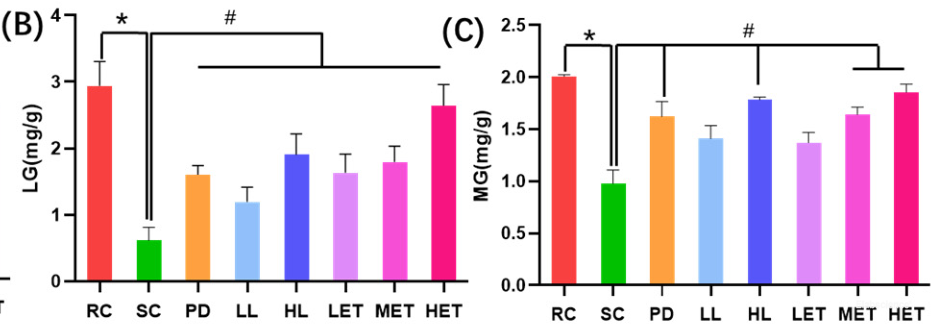Glycogen Colorimetric Assay Kit (Liver/Muscle Samples)
SKU: E-BC-K073-S-100
To better serve you, we would like to discuss your specific requirement.
Please Contact Us for a quote.
Glycogen Colorimetric Assay Kit (Liver/Muscle Samples)
| SKU # | E-BC-K073-S |
| Detection Instrument | Spectrophotometer (620 nm) |
| Detection Method | Colorimetric method |
Product Details
Properties
| Sample Type | Animal liver, muscle |
| Sensitivity | 1.80 mg/g liver tissue |
| Detection Range | 1.80-180 mg/g liver |
| Detection Method | Colorimetric method |
| Assay type | Quantitative |
| Assay time | 50 min |
| Precision | Average inter-assay CV: 7.300% | Average intra-assay CV: 3.700% |
| Other instruments required | Micropipettor, Incubator, Vortex mixer, Centrifuge |
| Other reagents required |
Normal saline (0.9% NaCl), Concentrated sulfuric acid |
| Storage | 2-8℃ |
| Valid period | 12 months |
Images
YF Peng et al investigates the function of Lycium barbarum polysaccharide in regulating oxidative stress and energy metabolism in rat. Glycogen of rat liver and muscle was determined using glycogen colorimetric assay kit (E-BC-K073-S).

The concentration of glycogen I liver and muscle were significantly changed in different group. (*P<0.05 vs. RC, #P<0.05 vs. SC)
Detection Principle
Under the presence of concentrated sulfuric acid, glycogen can be dehydrated to furfural derivatives. Furfural derivatives can form blue compound with anthracenone. The concentration of the compound can be measured by colorimetric quantification at 620 nm with glucose standard buffer of same treatment. Glycogen is quite stable in concentrated alkali solution. Heating the tissue sample in concentrated alkali solution before color development will remove other components and keep the glycogen.
Kit Components & Storage
| Item | Component | Size 1 (50 assays) | Size 2 (100 assays) | Storage |
| Reagent 1 | Alkali Reagent | 50 mL ×1 vial | 50 mL ×2 vials | 2-8℃, 12 month |
| Reagent 2 | Glucose Standard Solution | 1 mL ×1 vial | 1 mL × 1 vial | 2-8℃, 12 month shading light |
| Reagent 3 | Anthracenone | Powder × 6 vials | Powder × 12 vials | 2-8℃, 12 month shading light |
Note: The reagents must be stored strictly according to the preservation conditions in the above table. The reagents in different kits cannot be mixed with each other. For a small volume of reagents, please centrifuge before use, so as not to obtain sufficient amount of reagents.
Technical Data:
Parameter:
Intra-assay Precision
Three mouse liver tissue samples were assayed in replicates of 20 to determine precision within an assay (CV = Coefficient of Variation).
| Parameters | Sample 1 | Sample 2 | Sample 3 |
| Mean (mg/g) | 5.80 | 16.70 | 45.60 |
| %CV | 3.9 | 3.7 | 3.5 |
Inter-assay Precision
Three mouse liver tissue samples were assayed 20 times in duplicate by three operators to determine precision between assays.
| Parameters | Sample 1 | Sample 2 | Sample 3 |
| Mean (mg/g) | 5.80 | 16.70 | 45.60 |
| %CV | 6.9 | 7.5 | 7.5 |
Recovery
Take three samples of high concentration, middle concentration and low concentration to test the samples of each concentration for 6 times parallelly to get the average recovery rate of 101%.
| Sample 1 | Sample 2 | Sample 3 | |
| Expected Conc. (mg/g) | 26.4 | 78.6 | 154.5 |
| Observed Conc. (mg/g) | 26.7 | 81.0 | 153.0 |
| Recovery rate (%) | 101 | 103 | 99 |
Sensitivity
The analytical sensitivity of the assay is 1.8 mg/g liver tissue or 0.36 mg/g muscle tissue. This was determined by adding two standard deviations to the mean O.D. obtained when the zero standard was assayed 20 times, and calculating the corresponding concentration.
Standard Curve
As the OD value of the standard curve may vary according to the conditions of the actual assay performance (e.g. operator, pipetting technique or temperature effects), so the standard curve and data are provided as below for reference only:
| Concentration (μmol/L) | 0 | 0.01 | 0.04 | 0.07 | 0.1 | 0.15 | 0.2 |
| Average OD | 0.058 | 0.170 | 0.450 | 0.746 | 1.055 | 1.534 | 2.016 |
| Absoluted OD | 0 | 0.112 | 0.392 | 0.688 | 0.997 | 1.476 | 1.958 |



